The Sony Xperia 1 Review: A 21:9 Take of the World
by Andrei Frumusanu on July 26, 2019 8:00 AM EST- Posted in
- Mobile
- Sony
- Smartphones
- Xperia 1
Display Measurement - Professional 4K Screen?
The centre-piece of the Xperia 1 is the new 4K OLED screen. This is the first of its kind in smartphones, and Sony’s marketing focuses very strongly around it.
The display panel is supplied by Samsung and uses a newer DDIC generation. I’ve been trying to investigate as to how Sony implemented the 4K resolution in terms of the connectivity between the SoC and the DDIC. Whilst I haven’t been able to find explicit mention of it, I do think that the phone uses two MIPI interfaces as I’ve seen software evidence of the display rendering in two halves. The reason for going with two interfaces is that a single MIPI-DSI with D-PHY 1.1 or earlier is that the interface doesn’t have sufficient bandwidth to transport resolutions higher than 1440p at 60Hz, even with DSC (Display Stream Compression).
OnePlus surprised me earlier this summer with the OnePlus 7 Pro which was seemingly bypassing this limit and employs a 1440p 90Hz screen with a single interface, resulting in lower power draw than expected.
My assumption on Sony using dual interfaces is also strengthened by the base power draw of the phone: At 538mW all black screen it’s noticeably higher than the competition, which again likely is due to the higher resolution and the DDIC having to work more pixels.
As for the 4K resolution itself: It’s immensely sharp, however I have to remind users that everyday applications are not actually rendered at the native 4K, but rather at a reduced resolution of 1440p. The full resolution is only available when viewing pictures in the native photo app, or when viewing videos on YouTube or applications such as NetFlix. I do find this somewhat of a pity as text rendering would be very much the use-case that would most benefit from the higher resolution.
However, even though the software only renders 1440p in applications, it’s still a much better experience and it’s still a lot sharper than a regular 1440p screen. The OLED’s pentile display matrix is still a ton finer and the scaling and interpolation still greatly benefits the sharpness of the content, even at 1440p rendering. In fact, even though I’m near-sighted, I’m not able to make out the pixel matrix of the display even at the closest possible distance my eyes can focus at, whilst I do see it on 1440p panels such as on the S10+’s.
In general, one can argue that the 4K display is pretty much overkill for everyday scenarios, and I would actually agree with that notion. The times where I would actually have close enough and bright enough for the resolution to make a notable difference in experience is very rare.
We move on to the display calibration and fundamental display measurements of the Xperia 1 screen. As always, we thank X-Rite and SpecraCal, as our measurements are performed with an X-Rite i1Pro 2 spectrophotometer, with the exception of black levels which are measured with an i1Display Pro colorimeter. Data is collected and examined using SpectraCal's CalMAN software.


In terms of the brightness characteristics of the display, the phone goes up to around 331 nits at maximum manual brightness, and will go to up to 550 nits in adaptive brightness mode when under bright conditions (APL100). The screen has adaptive brightness scaling with APL so it will go brighter in peak brightness for lower APL content, and in general I found zero issues with the display’s performance even under direct sunlight, as it still managed excellent contrast levels.
Yes, unlike what the configuration settings menu says and what Sony keeps annoying reminding you of via notification when in the mode, the Creator mode isn’t actually a BT.2020 colour gamut. Frankly I have no idea where this BT.2020 gamut is supposed to appear as I haven’t been able to find any content or mode that triggers it. There’s no evidence of it in the phone’s drivers, and even any HDR video content will specifically have the panel switch to a P3 gamut. I’ve reached out to Sony for clarification, but at time of writing haven’t heard anything back yet.
Furthermore, the “10-bit colour” part also is seemingly misleading. The display panel is only 8-bit and it relies on tone-mapping to display 10-bit HDR content, which is essentially standard for how any other phone does it.
In fact, when reading the Xperia 1’s specification sheet, we find a few footnotes in regards to the gamut and the bit depth, as if Sony’s legal department realised their marketing department was a bit too eager in terms of making claims.
The colour temperature controls however are quite welcome: here Sony allows pre-sets as well as manual controls for both display modes, which is better than what a lot of other vendors offer. Unfortunately I found that none of the pre-sets actually target a 6500K temperature, but since this can be customised and the UI has discrete values, I’m able to share my settings like how I calibrated it on my review unit.
The phone comes in the standard mode with a much too inaccurate and cold colour temperature, which is a bit disappointing given how Sony markets this as a great content creator screen. Setting the Creator mode we also see that even on the “Warm” setting things are still far too blue with an average CCT of 7071K. I set up a custom setting getting accurate 100% white at near 6500K, however we still see the temperature still varies quite a bit at the lower levels and is sometimes too blue, resulting in the average of 6700K.
What is really out of the norm here is that Sony is targeting a gamma of 2.5 for the Creator mode. I’m not sure if this is deliberate or not, but it’s not exactly in line with DCI-P3 which targets a gamma of 2.6, nor is it in line with Display P3 which targets 2.2. In fact, because this is a sRGB gamut for most content I’d argue it’s completely off the mark with any standard.
Oddly enough again, the “Standard” mode doesn’t have nearly as a high gamma, whilst still not accurate to a target of 2.2, it ends up still a bit off at 2.31. It’s to be noted that these measurements were done at APL50 and windows size of 50%, which due to the display’s adaptive brightness can impact the accuracy of the numbers.

Creator Warm against Gamma 2.2
Looking at the patterns, we again see that the default Warm mode is too blue, and we also see the tones are too dark.

Creator Custom against Gamma 2.2
Correcting the colour temperature resolves one issue, but the gamma problem is still present and we’re not able to fix this.

Creator Custom against Gamma 2.5
Comparing the result again against a gamma target of 2.5, we see nearly perfect patterns, pointing towards that this was indeed a deliberate calibration for the 2.5 target.

Standard Custom against Gamma 2.2
Finally, the standard mode with corrected temperature is near accurate with just a slight offset in the gamma.

In the end, the greyscale accuracy of the phone isn’t very good with a dE2000 of 3.54. The colour temperature can be improved with the aforementioned custom settings and this does improve the score a bit, however the gamma issue isn’t something that’s solvable for the Creator mode and the phone is far off the mark for the standard consumer content target of 2.2.
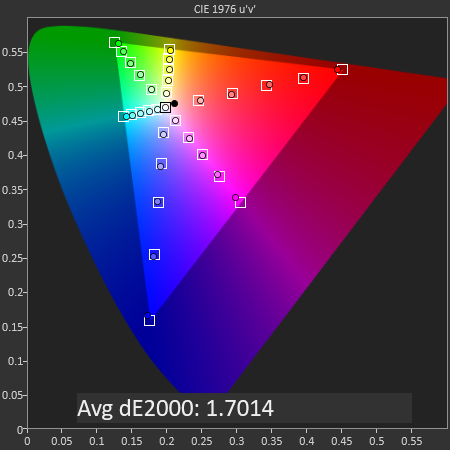

SpectraCal CalMAN
Creator (sRGB) against Gamma 2.2 and Gamma 2.5
Moving onto the saturation accuracy measurements, we’re seeing some interesting but troubling behaviour. When measuring against a target gamma of 2.2, the saturations look seemingly correct with an overall dE2000 of 1.7. However, we did discover that the greyscale levels aren’t targeting a gamma of 2.2 but rather 2.5. When comparing the saturations against such a target, we see that they’re far off and not quite reaching the levels they should be.
This is a bit of a contradiction and the only possible explanation is that the display is simply miscalibrated, with the luminosity values being off while the chromacity values aren’t quite as bad against a 2.2 gamma.
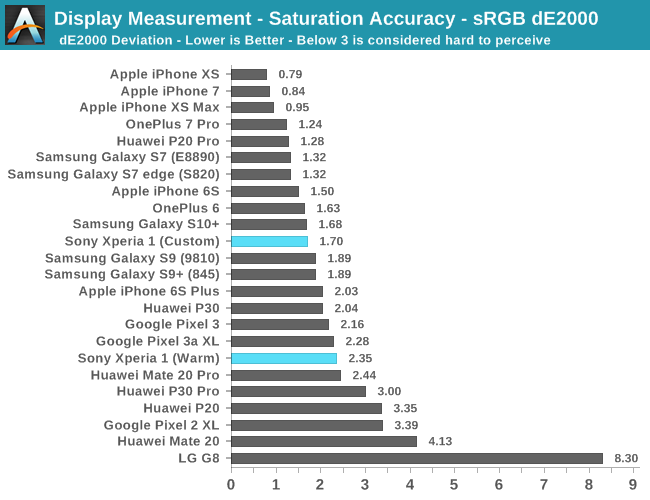
Overall, the saturation values with the corrected colour temperature target isn’t quite bad with a dE2000 of 1.7, while the warm preset comes at a worse off 2.35.
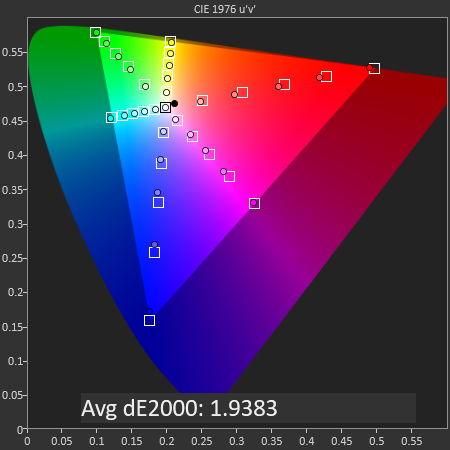
SpectraCal CalMAN
Standard (Display P3) versus Gamma 2.2
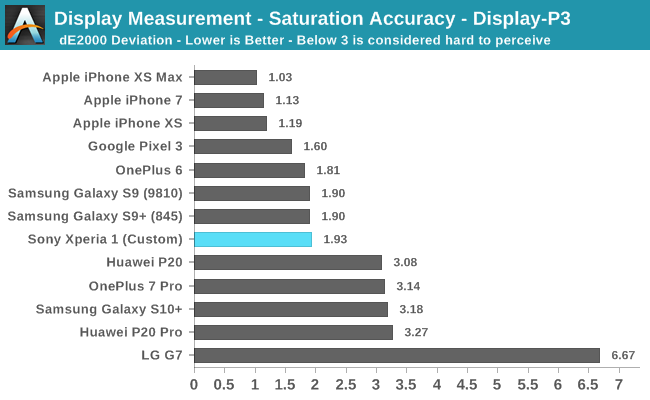
The “Standard” mode which targets the P3 space is adequate and ends up with a dE2000 of 1.93. It’s to be noted that a P3 target is also used for video content, however I don’t have a test methodology prepared for video and as such not able to measure it in the Creator mode.
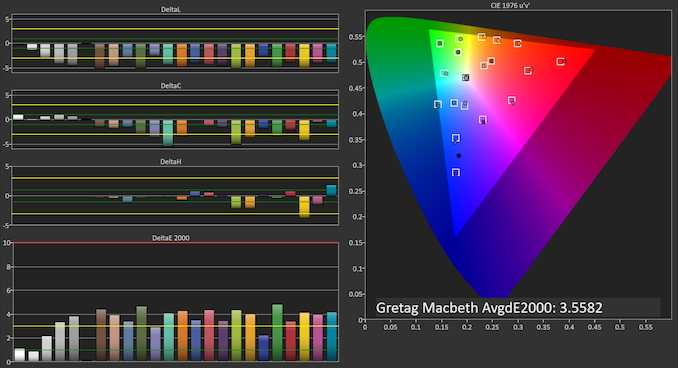
SpectraCal CalMAN
GMB Creator Custom against Gamma 2.2
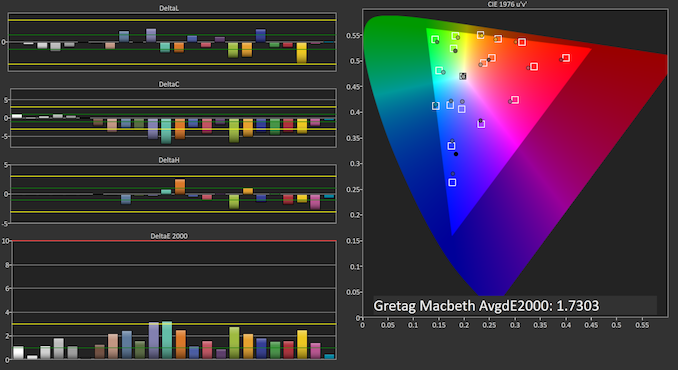
SpectraCal CalMAN
GMB Creator Custom against Gamma 2.5
Finally, the Gretag MacBeth chart of common colour tones better represents the oveall accuracy of the display. I again present the chart both against a gamma target of 2.2 as well as 2.5, and we again see that in the latter target we see the luminosity error of the Xperia 1’s Creator mode disappear.
Unfortunately in both modes there’s still a large chromacity error due to undersaturation (and in general due to the not full coverage of sRGB), which does give the display a worse off result.

Display Conclusion
Overall the Xperia 1’s display is a double-edged sword. The panel itself is excellent with fantastic viewing angles and the 4K resolution gives for outstanding uniformity and sharpness that is above that of other displays. On the other hand, 4K is very much overkill and unless you’re used to holding phones right up to your face, you will not be able to tell the difference to a regular 1440p screen.
Colour calibration of the Xperia 1 is very odd and very much off the mark. The Creator Mode which is supposed to be an accurate display mode for professionals and content creators is very evidently the mode which has the worst problems, which is ironic. There’s a very stark contradiction between the gamma behaviour of the luminosity and the chromacity of colours, and it somehow feels like a repeat of what we saw on Google’s Pixel phones, only this time around it’s very embarrassing for Sony as they’re actively promoting the mode in the phone as well as the marketing materials.
In general the issue with the gamma is that things appear too dark, and in the very first few hours I had with the phone this had given me the false impression that the screen just doesn’t get as bright as it should.
The colour temperature settings are also disappointing as none of the presets actually target the more accurate 6500K white point, with all of them being far too cold. At least here Sony gives the option to fine-tune it and we’re able to share the discrete values for better white levels.
Overall, it’s still a good display, but given the Xperia 1’s price point and targeted audience, I expected a lot more on the software side of things as the calibration just seems amateurish.


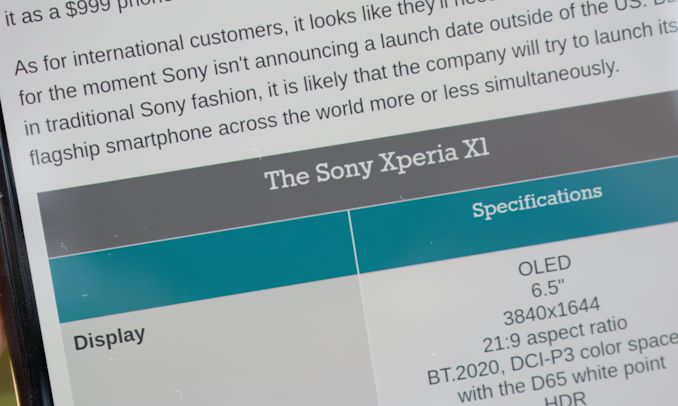

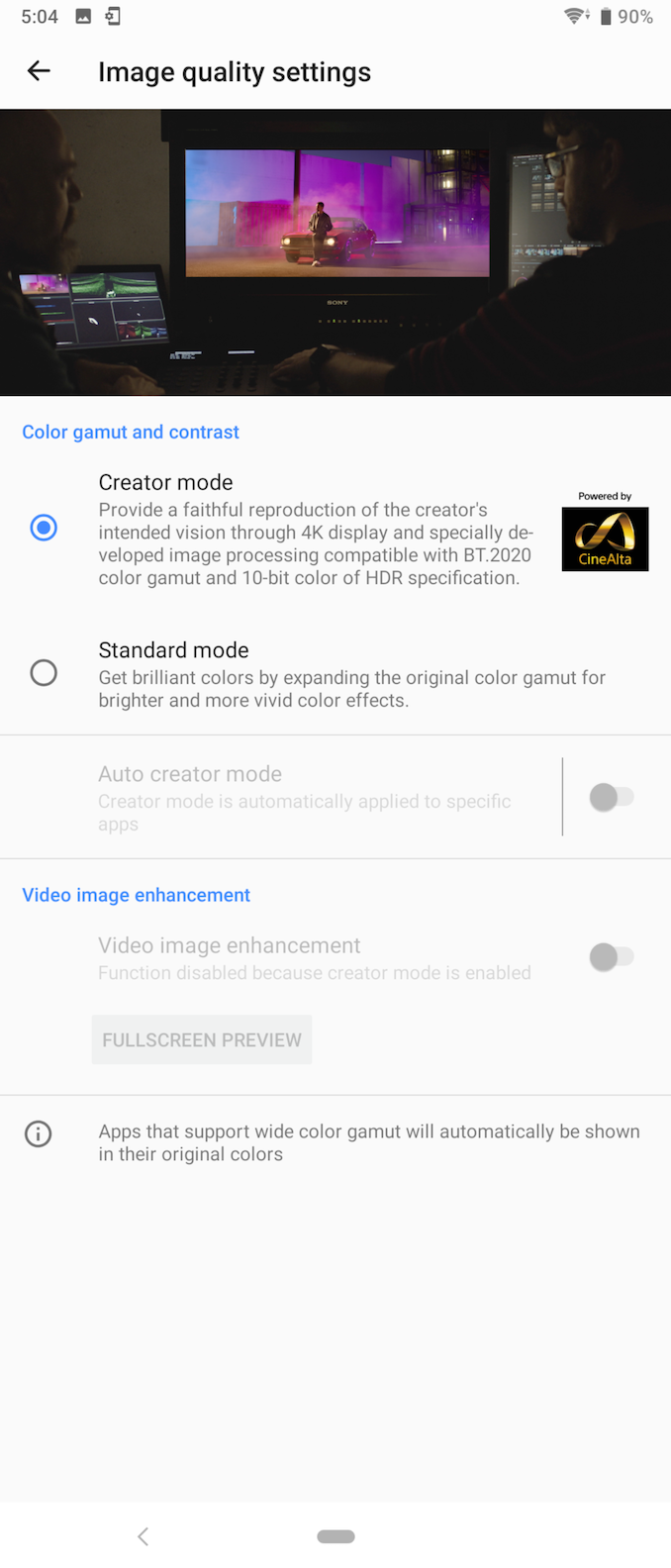
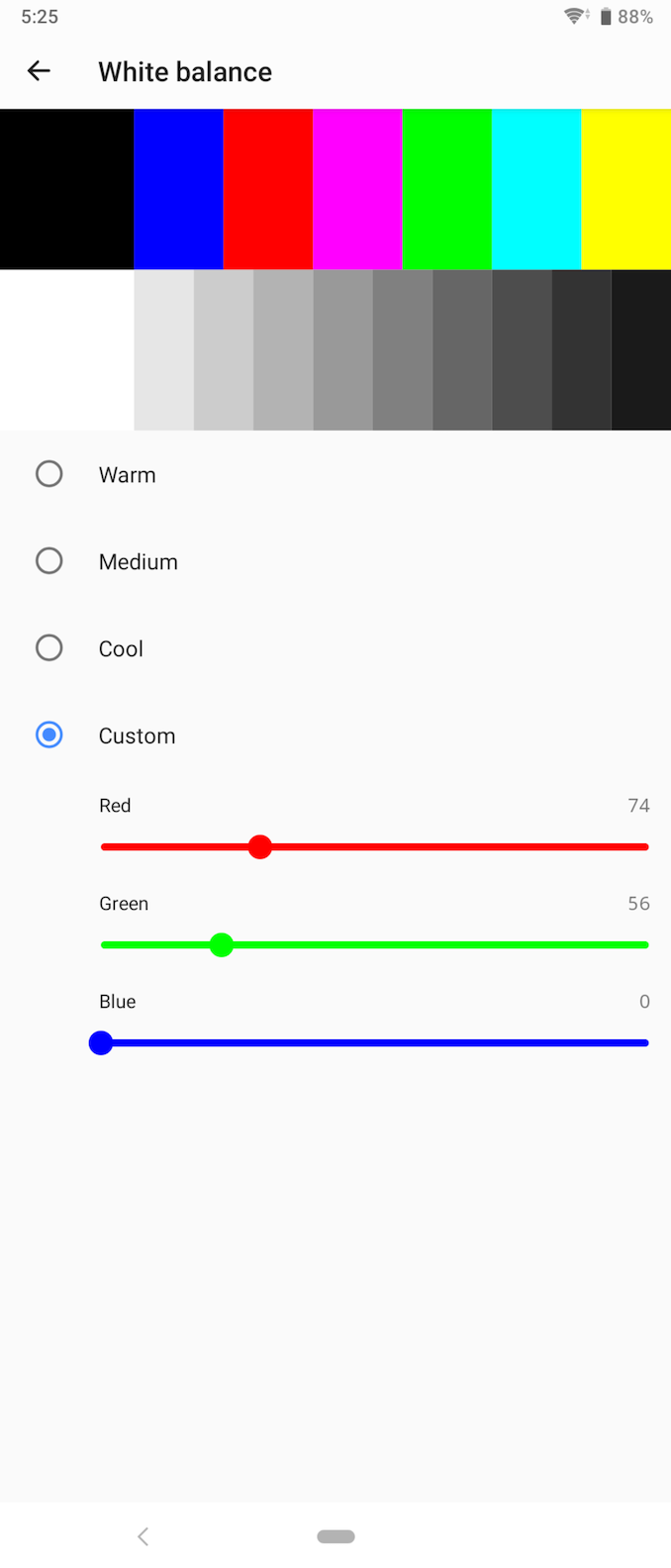
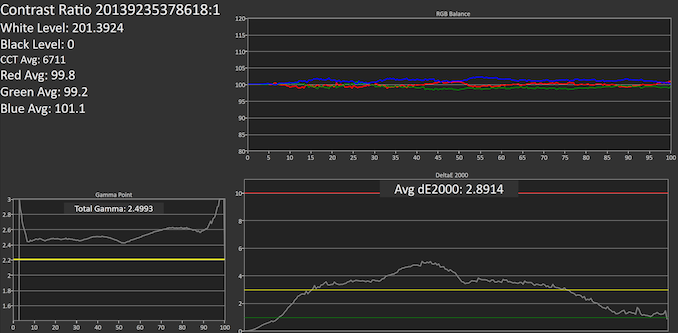








75 Comments
View All Comments
FunBunny2 - Saturday, July 27, 2019 - link
"I use it whenever I can, especially when I'm at work where i need to keep the phone charge."As I understand it, these sorts of batteries are limited by the number of charge cycles, irregardless of how much charge is made each time. IOW, repeated teeny charges chew up that limit long before the battery is really dead.
cfenton - Saturday, July 27, 2019 - link
That's not correct. A charge cycle is made up of 100% of the capacity of the battery. It doesn't matter if it's one 100% charge, two 50% charges, or ten 10% charges. Each of those count as one charge cycle. That's a bit of an oversimplification, but what's important is that a series of small charges are not each an entire charge cycle.s.yu - Sunday, July 28, 2019 - link
Wow, I didn't realize some people still use "irregardless".s.yu - Sunday, July 28, 2019 - link
You're doing it all wrong. Well the tech tree's grown in the wrong direction thanks to Apple's greed too. There's supposed to be two C ports, keep a magnetic adapter plugged in one and use headphones in the other, or if you actually just use BT then keep the C port plugged with a magnetic adapter and use magnetic cords, they work like Magsafe only they also transfer data. Hold the adapter close to the cord and it attaches automatically, you could charge your phone, use it in your hand, and hold that toddler with the other.That I can't give up the magnetic charging is a major reason why I won't consider any device without a headphone jack, the C port is always occupied and pulling the magnetic adapter out then inserting a C-3.5 adapter is ridiculous and unacceptable.
flyingpants265 - Monday, July 29, 2019 - link
That sounds OK, but wireless charging PLUS two ports sounds even better.s.yu - Wednesday, July 31, 2019 - link
Yup, and I'd like a kitchen sink too.khanikun - Monday, July 29, 2019 - link
If it has wireless charging, guess what else it has? Plugged in charging too. It's not a one or the other, it's both. You get the option of both. Just because you don't use it, doesn't mean it's a useless feature. Just useless to some ppl.I don't care much about the camera in the phone, as I have a better point and shoot. So quality of it doesn't matter to me, but doesn't negate that other people want a good camera in the phone. So of course, some ppl will grumble about it.
flyingpants265 - Monday, July 29, 2019 - link
No, it's so you can charge the phone with one hand, it takes only 1 second, as opposed to 3-5 seconds plugging and replugging my cable each time. Phone is basically at 100% all the time. and not need to plug the cable in, wiggle it around, and eventually bust the USB-C port. Those ports and their internal assemblies are quite fragile. It also doesn't need to add any thickness, as the wireless charging pad can be inside an external case, wired to the phone through a contact pad like on an older Xperia.No babbling about how you've personally never broken one, please. USB port is one of the most common fixes, apart from screen. Anandtech users are supposed to be power-users, yet you keep spending $900 on phones lacking basic features.
yacoub35 - Friday, July 26, 2019 - link
lol @ no headphone jack. what a failure for a device with a resolution so clearly intended for movie watching.UtilityMax - Thursday, August 1, 2019 - link
This makes choosing the next phone so much easier. Galaxy S10 for the high end, or Pixel 3A for less money.